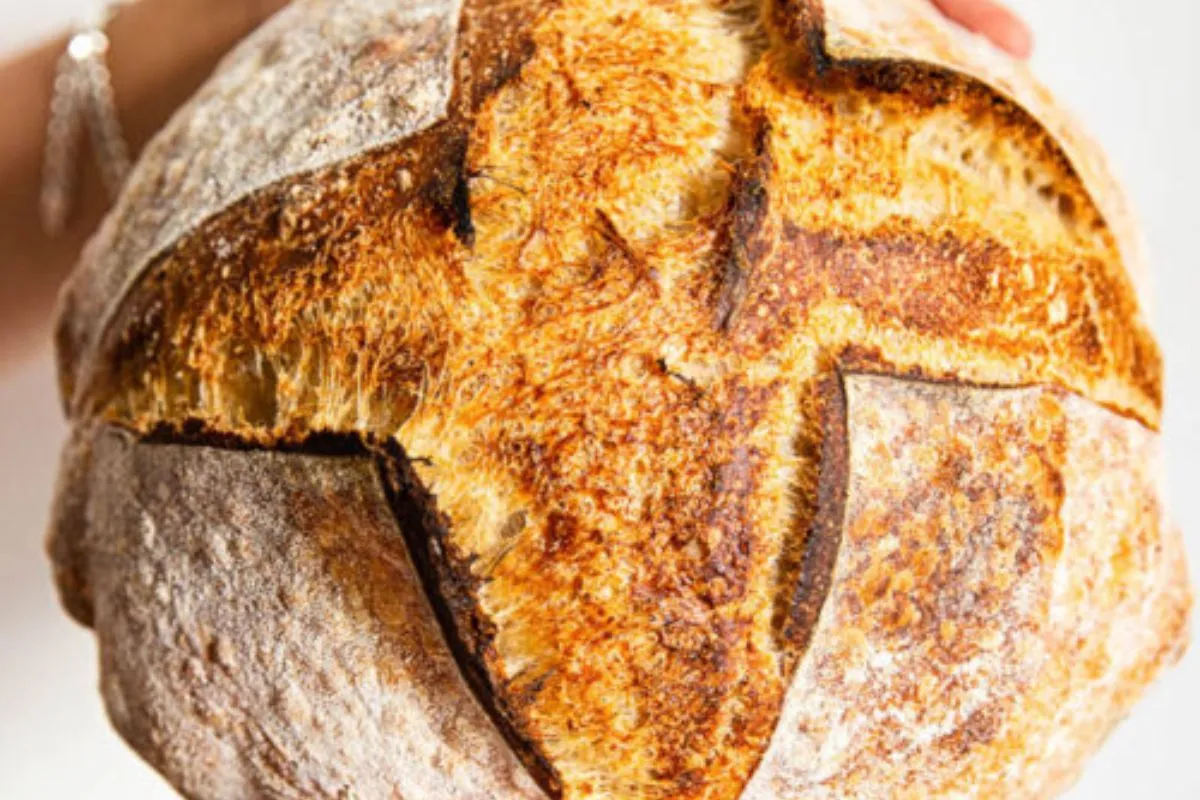
5 Surprising Ways to Reduce the Sourness in Your Sourdough Bread
Sourdough bread has always been my go-to choice when it comes to a delicious and healthy bread option. I love the fact that it’s free from processed and refined ingredients commonly found in store-bought bread. However, there are occasions when the sourness of the bread can be a bit overwhelming, especially for those who prefer a milder taste like myself.
Thankfully, I’ve discovered some surprising techniques that can help reduce the sourness without compromising the bread’s quality. Through my exploration, I’ve gained valuable insights and knowledge on achieving the perfect balance of flavors in homemade sourdough bread.
In this article, I’ll be sharing these techniques with you, so you too can enjoy the delightful goodness of sourdough bread with just the right amount of tanginess.
Table of Contents
ToggleWhy Sourdough Bread Can Be Too Sour
Before we dive into how to reduce the sourness in sourdough bread, let’s first understand why it can be too sour in the first place. Sourdough bread is made using a naturally occurring yeast and bacteria culture that ferments the dough over a period of time.
This fermentation process is what gives sourdough bread its signature sour taste. However, the sourness can vary depending on several factors, including the type of flour used, the feeding schedule of the sourdough starter, the temperature and humidity during fermentation, and the amount of sourdough starter used in the dough.
Some people enjoy a strong sour flavor, while others prefer a milder taste. If you’re one of those who wants to reduce the sourness in your sourdough bread, you’ll be pleased to know that there are ways to achieve this without sacrificing the health benefits that come with it.
5 Surprising Ways to Reduce the Sourness in Your Sourdough Bread
Discover the secret techniques for taming the sourness in your sourdough bread with these 5 surprising and innovative methods.
1. Adjusting Fermentation Time
The sourness of sourdough bread is largely influenced by the duration of fermentation. When the fermentation period is prolonged, it creates an ideal environment for increased lactic acid production, which enhances the tangy flavor. Conversely, shortening the fermentation time can help temper the sourness, yielding a milder taste.
To adjust the sourness level to suit personal preferences, one can experiment with modifying the proofing time or adjusting the fermentation temperature.
By reducing the proofing time or adjusting the temperature during fermentation, it is possible to exert control over the development of sourness in the bread. This flexibility allows bakers and bread enthusiasts to achieve the desired balance of flavors, ensuring that every loaf of sourdough bread is tailored to individual taste preferences.
2. Incorporating Whole Wheat Flour
Incorporating a higher percentage of whole wheat flour into your sourdough bread recipe can play a pivotal role in diminishing its sourness. Whole wheat flour introduces a gentle sweetness and nuttiness to the bread, which works harmoniously to counterbalance the tanginess imparted by the sourdough culture.
By experimenting with varying proportions of whole wheat flour and all-purpose flour, you can embark on a quest to discover the optimal balance that caters to your unique palate.
Adjusting the ratio allows you to fine-tune the flavor profile of your bread, resulting in a more nuanced and satisfying taste experience. Whether you prefer a milder, subtly sour loaf or a bolder tang, the versatility of using different proportions of whole wheat flour empowers you to create sourdough bread that is truly customized to your personal preferences.
3. Adding a Touch of Honey
Harnessing the power of nature’s sweetener, honey, can effectively counter the sourness in your sourdough bread. When crafting your dough, incorporating a modest quantity of honey can work wonders. The natural sweetness of honey seamlessly melds with the tangy undertones, culminating in a harmoniously balanced flavor profile.
However, it is crucial to exercise caution with the amount used, as an excessive quantity of honey can overpower the other intricate flavors present in the bread.
Finding the perfect balance requires a delicate touch and some experimentation. By judiciously adding honey to your sourdough bread recipe, you can achieve a delightful interplay of flavors, with the honey acting as a mediator that bridges the gap between the sour and the sweet.
This approach elevates the overall taste experience, providing a nuanced and enjoyable journey for your taste buds.
4. Pre-soaking the Flour
Pre-soaking the flour is an unexpected yet effective approach to minimize the tangy flavor in sourdough bread. This intriguing technique entails combining the flour with water and permitting it to sit undisturbed for several hours or even overnight, prior to adding it to the dough mixture.
The act of pre-soaking the flour facilitates the breakdown of enzymes responsible for the sourness, subsequently leading to a more subdued taste sensation. By allowing the flour to rest in water, the natural fermentation process is initiated, allowing beneficial microbes to develop and metabolize the flour’s components.
This gentle treatment of the flour not only tempers the acidity but also promotes improved texture and enhanced flavors. Embracing this surprising method can bring about delightful results, transforming your sourdough bread into a more palatable and enjoyable culinary experience.
5. Retarding the Dough in the Fridge
Retarding the dough is a remarkable practice wherein the dough is fermented at a lower temperature, often within the confines of a refrigerator. This method intentionally decelerates the fermentation process, affording ample time for flavors to mature gradually.
By opting to retard the dough overnight or for an extended duration, you can effortlessly diminish the intensity of sourness, ultimately attaining a harmonious and well-rounded flavor profile in your sourdough bread.
This technique not only imparts a subtler tang but also allows the other complex flavors to develop, resulting in a more nuanced and enjoyable eating experience.
The prolonged fermentation period, coupled with the controlled temperature, encourages the growth of beneficial microorganisms and enzymes, thereby enhancing both the texture and taste of the final baked loaf. Embracing this approach empowers you to achieve a superbly balanced sourdough bread that delights the palate with every bite.

Common Mistakes to Avoid When Reducing Sourness in Sourdough Bread
While it’s relatively straightforward to reduce the sourness in your sourdough bread, there are some common mistakes to avoid to ensure successful results.
- Insufficient Fermentation Time: If you cut the fermentation time too short, the flavors may not have a chance to develop fully, leading to a lack of complexity and insufficient reduction in sourness. Be patient and allow enough time for fermentation, adjusting it gradually to achieve the desired taste.
- Overproofing the Dough: On the other hand, overproofing the dough can lead to excessive sourness. When the dough is left to ferment for too long, the bacteria can produce an abundance of acids, resulting in an overly tangy flavor. Pay attention to the dough’s volume and texture during proofing to avoid overfermentation.
- Inconsistent Feeding Schedule: Neglecting to maintain a consistent feeding schedule for your sourdough starter can affect its acidity and, consequently, the sourness of your bread. Feed your starter regularly at consistent intervals to keep the fermentation process stable and predictable.
- Using Excessively Sour Starter: If your starter has a very strong, overpowering sourness, it will transfer that flavor to your bread. Consider refreshing your starter a few times before using it in your bread recipe to reduce its acidity.
- Inadequate Dough Handling: Mishandling the dough during shaping and proofing can lead to uneven fermentation and sourness distribution. Follow proper dough handling techniques, including gentle shaping and proper tension, to ensure consistent results.
Tips for Maintaining a Consistent Sourness Level in Your Sourdough Bread
Once you achieve the desired level of sourness in your sourdough bread, you may want to maintain that consistency for future bakes. Here are some tips to help you achieve a consistent sourness level:
- Keep Detailed Records: Maintain a baking journal to record your fermentation times, temperature, hydration levels, and other factors that influence the sourness of your bread. By referring to these records, you can replicate successful results and adjust as needed.
- Maintain a Stable Starter: Regularly feeding and refreshing your sourdough starter helps maintain its balance of acidity and promotes consistent fermentation. Keep your starter healthy, active, and well-maintained for reliable results.
- Control Fermentation Temperature: Temperature plays a crucial role in fermentation. Experiment with different temperatures to find the sweet spot that produces the desired level of sourness. Consistently monitor and control the temperature during fermentation to achieve consistent results.
- Adjust Fermentation Time: Fine-tune the fermentation time according to your preferences. If you desire a milder flavor, shorten the fermentation period, and vice versa. Keep track of the changes you make and adjust gradually until you find the perfect balance.
- Practice Consistent Dough Handling: Develop good dough handling techniques and practice them consistently. Proper shaping, gentle handling, and appropriate proofing contribute to even fermentation and consistent sourness levels throughout your bread.
By following these tips and learning from your baking experiences, you can master the art of achieving a consistent sourness level in your sourdough bread, allowing you to enjoy your favorite flavor profile time and time again.
Frequently Asked Questions About Reducing Sourness In Sourdough Bread
Can I reduce the sourness of my sourdough bread without compromising its texture?
Yes, you can reduce the sourness while maintaining the texture of your sourdough bread. By implementing the techniques mentioned above, such as adjusting fermentation time, incorporating whole wheat flour, adding honey, pre-soaking the flour, or retarding the dough in the fridge, you can achieve a milder taste without sacrificing the desired texture.
How long should I ferment my sourdough bread to reduce the sourness?
The fermentation time required to reduce the sourness can vary depending on the specific recipe and environmental conditions. However, as a general guideline, you can try shortening the fermentation time by a few hours or adjusting the proofing temperature slightly lower to achieve a less tangy flavor. It’s best to experiment with different fermentation times until you find the perfect balance for your taste preferences.
Can I substitute other sweeteners for honey in my sourdough bread?
Certainly! If you prefer to avoid honey or are looking for alternative sweeteners, you can experiment with options like maple syrup, agave nectar, or coconut sugar. Keep in mind that each sweetener will impart a slightly different flavor profile, so it’s essential to adjust the quantity according to your taste and gradually test different variations.
Is it necessary to pre-soak the flour for reducing sourness?
Pre-soaking the flour is not a mandatory step, but it can be an effective method to reduce the sourness in your sourdough bread. If you find that your bread consistently turns out too tangy, you can try pre-soaking the flour for a few hours or overnight before proceeding with the recipe. This technique helps to neutralize the enzymes responsible for the excessive sourness, resulting in a milder flavor.
Can I use a combination of these techniques?
Absolutely! In fact, combining multiple techniques can yield even better results in reducing the sourness of your sourdough bread. You can experiment with adjusting fermentation time, incorporating whole wheat flour, adding honey, pre-soaking the flour, and retarding the dough to find the ideal combination that suits your taste preferences.
Conclusion
Reducing the sourness in your sourdough bread is possible through various creative approaches. By adjusting the fermentation time, incorporating whole wheat flour, adding honey, pre-soaking the flour, or retarding the dough, you can achieve a more balanced and milder flavor profile without compromising the quality of your homemade bread.
Don’t be afraid to experiment and tailor these techniques to suit your personal taste preferences. Enjoy the process of baking and savor the delightful results of your endeavors!
Lindsey Mackenzie
About me
Hi there! I’m Lindsey Mackenzie, the founder of Bake Smartly. Baking has been my passion since childhood, growing up in my father’s bakery. With Bake Smartly, I’m excited to share my love for all things sweet and savory. Join me on this delicious journey as we whip up scrumptious treats and sprinkle joy into every bite!






